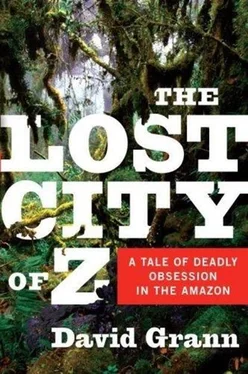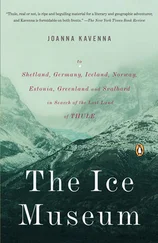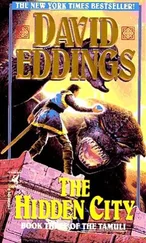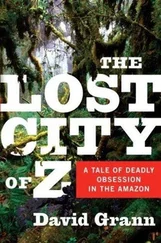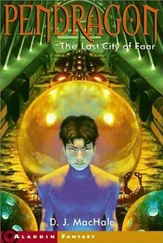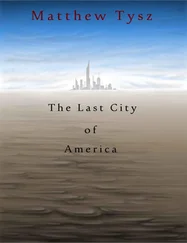As Fawcett and Chivers descended deeper into this world, they reached the distant outpost of Riberalta. There, Fawcett watched a boat pulling along the bank. A worker yelled, “Here come the cattle!”-and Fawcett saw guards with whips driving a chain of about thirty Indian men and women onshore, where buyers began to inspect them. Fawcett asked a customs officer who these people were. Slaves, the officer replied.
Fawcett was shocked to learn that, because so many workers died in the jungle, rubber barons, in order to replenish their labor supply, dispatched armed posses into the forest to kidnap and enslave tribes. In one instance along the Putumayo River in Peru, the horrors inflicted on the Indians became so notorious that the British government launched an investigation after it was revealed that the perpetrators had sold shares in their company on the London Stock Exchange. Evidence showed that the Peruvian Amazon Company had committed virtual genocide in attempting to pacify and enslave the native population: it castrated and beheaded Indians, poured gasoline on them and lit them afire, crucified them upside down, beat them, mutilated them, starved them, drowned them, and fed them to dogs. The company's henchmen also raped women and girls and smashed children's heads open. “In some sections such an odour of putrefying flesh arises from the numerous bodies of the victims that the places must be temporarily abandoned,” said an engineer who visited the area, which was dubbed the “devil's paradise.” Sir Roger Casement, the British consul general who led the investigation, estimated that some thirty thousand Indians had died at the hands of this one rubber company alone. A British diplomat concluded, “It is no exaggeration to say that this information as to the methods employed in the collection of rubber by the agents of the company surpass in horror anything hitherto reported to the civilized world during the last century.”
Long before the Casement report became public, in 1912, Fawcett denounced the atrocities in British newspaper editorials and in meetings with government officials. He once called the slave traders “savages” and “scum.” Moreover, he knew that the rubber boom had made his own mission exceedingly more difficult and dangerous. Even previously friendly tribes were now hostile to foreigners. Fawcett was told of one party of eighty men in which “so many of them were killed with poisoned arrows that the rest abandoned the trip and retired;” other travelers were found buried up to their waists and left to be eaten alive by fire ants, maggots, and bees. In the journal of the Royal Geographical Society, Fawcett wrote that “the wretched policy which created a slave trade, and openly encouraged a reckless slaughter of the indigenous Indians, many of them races of great intelligence,” had imbued the Indians with a “deadly vengeance against the stranger” and constituted one of “the great dangers of South American exploration.”
On September 25, 1906, Fawcett left Riberalta with Chivers, accompanied by twenty desperadoes and native guides he had recruited on the frontier. Among them was a Jamaican prospector named Willis, who, despite a penchant for liquor, was a first-rate cook and fisherman (“He could smell out food and drink as a hound smells out a rabbit,” Fawcett quipped), and a Bolivian former military officer who spoke fluent English and could serve as an interpreter. Fawcett had made sure that the men understood what they were getting themselves into. Anyone who broke a limb or fell sick deep in the jungle would have little chance of survival. To carry the person out would jeopardize the welfare of the entire party; the logic of the jungle dictated that the person be abandoned-or, as Fawcett grimly put it, “He has his choice of opium pills, starvation, or torture if he is found by savages.”
Using canoes that they built from trees, Fawcett and his men meandered westward on their planned route of nearly six hundred miles along the frontier between Brazil and Bolivia. The river was barricaded with fallen trees, and from the canoes Chivers and Fawcett tried to slash through them with machetes. Piranhas were abundant, and the explorers were careful not to let their fingers skim the river's surface. Theodore Roosevelt, after exploring an Amazon tributary in 1914, called the piranha “the most ferocious fish in the world.” He added, “They will rend and devour alive any wounded man or beast; for blood in the water excites them to madness… The head, with its short muzzle, staring malignant eyes and gaping, cruelly armoured jaws, is the embodiment of evil ferocity.”
When bathing, Fawcett nervously checked his body for boils and cuts. The first time he swam across a river, he said, “there was an unpleasant sinking feeling in the pit of my stomach.” In addition to piranhas, he dreaded candirus and electric eels, or puraques. The latter-about six feet long, with eyes set so far forward on their flattened heads that they nearly rested on their upper lips-were living batteries: they sent up to six hundred and fifty volts of electricity coursing through the bodies of their victims. They could electrocute a frog or a fish in a tank of water without ever touching it. The German explorer-scientist Alexander von Humboldt, who traveled along the Orinoco River in the Amazon at the beginning of the nineteenth century, drove, with the help of Indians holding harpoons, thirty horses and mules into a bog of water filled with electric eels to see what would happen. The horses and mules-manes erect, eyes inflamed-reared in terror as the eels surrounded them. Some horses tried to jump out of the water, but the Indians forced them back with the harpoons. Within seconds, two horses had drowned, while the rest eventually broke through the Indians' blockade and collapsed to the ground, exhausted and numb. “One shock is sufficient to paralyze and drown a man-but the way of the puraque is to repeat the shocks to make sure of its victim,” Fawcett wrote. He concluded that a person must do things in these parts that “carry no hope of epitaph-done in cold blood, and too often with an aftermath of tragedy.”
One day Fawcett spied something along the edge of the sluggish river. At first it looked like a fallen tree, but it began undulating toward the canoes. It was bigger than an electric eel, and when Fawcett's companions saw it they screamed. Fawcett lifted his rifle and fired at the object until smoke filled the air. When the creature ceased to move, the men pulled a canoe alongside it. It was an anaconda. In his reports to the Royal Geographical Society, Fawcett insisted that it was longer than sixty feet (“Great Snakes!” blared one headline in the British press), though much of the anaconda was submerged and it was surely smaller: the longest officially recorded one is twenty-seven feet nine inches. (At that length, a single anaconda can still weigh over half a ton and, because of its elastic jaw muscles, swallow a deer whole.) Staring at the motionless snake in front of him, Fawcett removed his knife. He tried to slice off a piece of its skin, to put it in a specimen jar, but as he cut into the anaconda it jolted toward Fawcett and his party-sending them fleeing in fear.
As the expedition pushed onward, its members gazed at the jungle. “It was one of the gloomiest journeys I had made, for the river was threatening in its quiet, and the easy current and deep water seemed to promise evils ahead,” Fawcett wrote months after leaving Riberalta. “The demons of the Amazonian rivers were abroad, manifesting their presence in lowering skies, downpours of torrential rain and somber forest walls.”
Fawcett enforced a strict regimen. According to Henry Costin, a former British corporal who went on several later expeditions with Fawcett, the party woke at first light with one person calling reveille. Then the men rushed down to the river, washed, brushed their teeth, and packed, while the person on breakfast duty started a fire. “We lived simply,” Costin recalled. “Breakfast would usually be porridge, tinned milk, lots of sugar.” Within minutes, the men were on their way. Collecting the extensive data for Fawcett's RGS reports-including surveys, sketches of the landscape, barometric and temperature readings, and catalogs of the flora and fauna- required painstaking work, and Fawcett toiled furiously. “Inactivity was what I couldn't stand,” he once said. The jungle seemed to exaggerate his fundamental nature: his bravery and toughness, along with his irascibility and intolerance of others' weakness. He allowed his men only a brief pause for lunch-a snack of a few biscuits-and trekked up to twelve hours a day.
Читать дальше
Конец ознакомительного отрывка
Купить книгу
